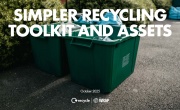ZWE report outlines current state of PET circularity
Zero Waste Europe has found that most Polyethylene terephthalate (PET) plastic recovered from bottles in Europe does not make its way back into new PET bottles. To improve circularity, the group states, significant improvements in design, collection and recycling are needed.
 In a report published today, entitled ‘How circular is PET?’, Zero Waste Europe (ZWE) presents a picture of the current state of circularity of the material in bottles in Europe – including how many bottles are collected for recycling; how many are actually recycled; and how many new bottles contain recycled PET.
In a report published today, entitled ‘How circular is PET?’, Zero Waste Europe (ZWE) presents a picture of the current state of circularity of the material in bottles in Europe – including how many bottles are collected for recycling; how many are actually recycled; and how many new bottles contain recycled PET.
The research, conducted for ZWE by Eunomia, finds that most recycled PET recovered from bottles in Europe is being used in other lower-grade PET applications – such as trays, film, strapping or fibres. New bottles placed on the market contain an average of only 17 per cent of recycled PET, despite the material having a recycling rate of around 50 per cent.
According to the report, recycled content for all PET product streams – including single-use plastic trays, textile fibres, films and strapping – is sourced from bottles, with the recycling rate of non-bottle PET applications being ‘very low’. Of the 1.8 million tonnes of recycled flake output from bottles, only 31 per cent is made into pellets for bottles, with the remaining 69 per cent going into other PET products.
The picture for PET bottle recycling, ZWE finds, varies across Europe. Some countries achieve high recycling rates, which the group attributes largely to the presence of Deposit Return Systems (DRS), whilst others have lower rates, typically only employing separate collection systems.
Looking at key EU policy changes and commitments from large brands to increase PET circularity, the report notes that higher levels of recycled content may be achievable with the increased uptake of DRS and a shift from coloured and opaque bottles to clear bottles. Prioritising bottle-to-bottle recycling is also identified as a means to drive up PET circularity, preventing cascade to other non-bottle PET applications.
ZWE additionally highlights the potential for chemical recycling technologies – such as depolymerisation – to contribute to overall PET circularity, but notes that such techniques must ‘reach full maturity’, their ‘full impact’ being assessed.
If such changes are implemented, ZWE states, it ‘may be possible’ to reach an upper limit between 61 and 75 per cent recycled content in bottles by 2030. Under current market conditions, this could reach as low as a minimum policy-driven target of 30 per cent.
Dorota Napierska, Policy Officer on Toxic-Free Consumption & Production at Zero Waste Europe, says: "This study shows that PET is not very circular today and will remain as such in the future unless substantial policy changes are introduced, and technical and economical barriers are removed.
“We might speculate that, if the most recyclable and recycled type of plastic struggles to meet the challenges of becoming more circular, the other types of plastic may face even greater challenges. Consequently, the most effective way to increase the circularity of this material is not only through recycling, but through its use on durable applications instead of disposable ones.”







